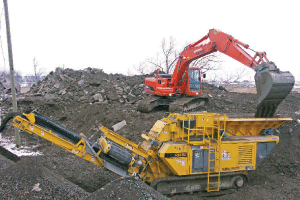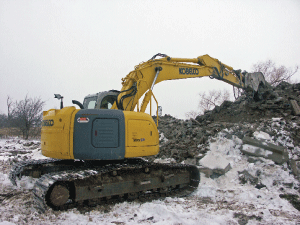
Features
Aggregates
Technology
Size does matter……for portable recycling operation
Size matters for portable recycling operation
July 24, 2008 By Andy Bateman
Compact equipment size, a small operating footprint and low operating costs have facilitated a successful first year for a new entrant in the aggregate recycling market.
Andy Miksys and Barry Upiter are partners in Oakville, Ont.-based AB Crushing Inc., a new operation targeting mostly the small volume end of the aggregate recycling market. While most individual crushing contracts are between 10 000 and 15 000 tonnes, some customer’s material stockpiles are larger and crushed in stages to suit demand. Contracts as small as 1000 tonnes, not typically of interest to contractors with larger crushing spreads, can also be viable for this compact set up thanks to lower capital and operating costs. According to Miksys, things are going to plan, with a solid start in 2007 and optimism that 2008 will see production increasing to 100 000 tonnes or more. Business will also be boosted by internal demand from a related construction company that has already realised cost savings by using recycled aggregates.
 |
|
The small footprint of the crushing set up allows
|
In the application seen by Aggregates & Roadbuilding, the simple set up consisted of two mid-size excavators and a track-mounted horizontal shaft impact crusher. The feed material consisted of a mixture of concrete, asphalt, broken rock and soil, including some reinforcing steel (rebar) in the concrete and individual pieces up to about 750 mm across. The product was a 19 mm minus granular base material which customer Mattamy Homes has found an effective alternative to virgin aggregates in site trailer bases, residential driveways, and similar applications.
The feed was prepared for crushing by a Kobelco 235SR LC excavator equipped with a pulverizer jaw to reduce oversize to about 450 mm and also remove some of the loose rebar (reinforcing steel) and other debris from the feed. The sized and sorted material was then fed to the Rubble Master RM80 compact recycler by a Doosan Daewoo Solar 225LCV excavator. Finished product was stockpiled directly from the crusher and cast out into larger stockpiles by the feed excavator when necessary. Miksys reports an average crushing rate of 100 tonnes/h here, a production rate which seemed fairly representative for the typical work this machine will do.
The RM80 incorporates several ways to adjust product gradation and throughput. At the feed end, operators have the option of directing a percentage of the fine material passing through its grizzly directly to the product conveyor or diverting some of the crusher bypass to a side conveyor for separate stockpiling. At the crushing stage, the back wall of the crushing chamber can be moved hydraulically both up and down as well as in and out. Raising the back wall reduces material retention time in the crusher, thereby increasing both the throughput rate and the size of the product. Should a finer product gradation be required, the wall would be moved to the lower position to increase retention time in the crusher. At the product discharge, an oversize separator can be added to re-crush oversize in closed circuit. The separator consists of three series of freely vibrating combs are slid into place on the end of the product conveyor. In operation, material retained on the combs is conveyed back to the feed hopper for re-crushing via a small side and return conveyor.
Other aspects of the RM80’s design aim to minimise downtime. Like many portable crushers it incorporates a magnet, in this case a permanent magnet, to remove ferrous material in the feed. Less common is the ability to lift the top cover of the crushing chamber entrance by remote control to prevent plug ups from oversize or bridged pieces. In addition, the ability to move the back wall of the chamber away from the rotor, again by remote control, allows the hammers to make contact with any jammed oversize and begin reduction. At the bottom of the crushing chamber, a deflector plate helps to protect the discharge conveyor from the impact of falling crushed material and rebar. In practice, the unit is reported to comfortably deal with pieces of rebar up to 19 mm in diameter and up to 1m long without rebar "bird’s nests" or conveyor damage.
For its owners, the small area required by the plant is an asset in more ways than one. Its Certificate of Approval limits, among other things, noise and dust exposure to
 |
|
A Kobelco 235SR LC excavator reduced oversize
|
neighbours, so the ability to tuck into a small area maximises the distance from surrounding properties. The Certificate will also reportedly give AB Crushing the province’s smallest environmental operating footprint, not surprising given a set up where feed and product stockpiles are separated by little more than the length of the crushing plant and the whole operation occupies an area only some 30 m x 30 m. That same small space requirement also means that the set up can tackle small volume crushing jobs not accessible to larger spreads.
Compact size and lightweight are also said to simplify transportation between contracts. The RM80 itself is a svelte 23 tonnes and can reportedly be driven straight on or off a three-axle trailer with minimal preparation other than normal operating checks. As might be expected, the compact size of the crusher also translates into smaller requirements for support equipment. At 22 tonnes, the 225LCV feed excavator is smaller and lighter than machines typically seen in portable recycling operations and is also fitted with a narrow bucket to facilitate feeding the RM80’s hopper from any angle. Miksys adds that the whole setup can be moved on three trailers or just two in cases where the feed material does not require significant pre-sorting or oversize crushing.
Specification data for the RM80 indicates production capacity of up to 150 tonnes/h, depending on feed material. Its principal components include a Deutz turbo diesel engine, Strickland transmission and Rexroth traction electric motors. The water-cooled engine provides 122 kW at 2000 rpm, with reported fuel consumption of just 15 to 17 litres/hr or more than a full shift of production from a 200 litre fuel tank. Dust suppression can be provided by spray bars supplied from a local water supply or a water tank.
Crusher inlet height and width are 533 mm and 635 mm respectively, while the maximum length of individual feed pieces is 686 mm. In terms of wear parts, the horizontal shaft impact crusher has four hammer slots, although in almost all cases only two hammers are active in the crushing process at any time. The hammers are replaced in pairs, with the opposite worn pair left in place to protect the rotor against material impact. Once the two new hammers becomes worn, they are left in place to protect the rotor and the opposite pair replaced to do the work of flinging feed material against the crushing chamber’s liner plates. In the near future, hammers supplied for this crusher will be colour coded for operator ease of use. A multipurpose hammer for most applications will be green while a hammer for feed containing only reclaimed asphalt pavement (RAP) will be yellow.
Print this page